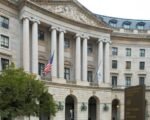US stock markets took a hit Monday after Moody’s Investors Service downgraded the US government’s credit rating from the top-tier Aaa to Aa1. This shift comes amid growing concerns over America’s soaring $36 trillion national debt and escalating borrowing costs, rattling investors globally.
The downgrade, which marks the third major credit rating cut since 2011, has injected fresh unease into markets already jittery about economic policy uncertainty, notably around President Donald Trump’s tax plans. The fallout has been felt worldwide — Asia-Pacific markets tumbled, and US Treasury yields spiked to new highs.
Moody’s Downgrade: What It Means and Why Now?
So, why did Moody’s decide to chip away at America’s prized triple-A status? Well, it boils down to finances that aren’t looking so hot. The rating agency pointed to the relentless climb of federal debt — now an eye-watering $36 trillion — combined with growing interest expenses. Basically, the government’s borrowing costs are ballooning, thanks to years of deficits and tax cuts that have left the coffers less full.
Moody’s statement was pretty direct: over the last decade, federal debt surged due to ongoing deficits. Spending increased, revenues fell, and interest payments shot up. This cocktail is now putting serious pressure on fiscal stability.
It’s worth noting this downgrade isn’t a surprise to market watchers. S&P was first to lower the US rating back in 2011, with Fitch following in 2023. Moody’s timing does seem to catch attention, especially as some Republican lawmakers push back against Trump’s aggressive tax cuts, fearing these moves will dig the deficit hole deeper.
But Treasury Secretary Scott Bessent shrugged off Moody’s verdict. He called the downgrade “a lagging indicator,” suggesting the agency’s judgment trails actual market conditions. He’s betting on economic growth outpacing debt accumulation to steady things out.

Markets React: Jitters Spread Across Global Exchanges
Once the news dropped, the reaction was swift. Asian stock markets led the sell-off, with indexes falling as traders digested the downgrade’s implications. Back in the US, futures pointed toward a rough open: the S&P 500 was expected to slide around 1%, while the tech-heavy Nasdaq faced a steeper fall near 1.3%.
Bond markets also felt the tremor. The yield on 30-year US Treasury bonds hit 5%, a level not seen since last April. That’s significant because yields move inversely to bond prices — meaning bondholders are demanding higher returns to compensate for perceived risk. It’s like lenders getting cold feet.
Gold prices climbed, too, as investors sought refuge in traditional safe havens amid rising market uncertainty. Meanwhile, the US dollar stumbled against a basket of other currencies, losing its usual “safe haven” shine.
Hargreaves Lansdown’s Susannah Streeter summed it up well: “Like a long weekend hangover, a headache of worry is seeping into sentiment today.” That pretty much nails the mood.
Political Turbulence and Fiscal Worries: What Lies Ahead?
Politics definitely plays a big role here. President Trump’s promises of sweeping tax cuts — the so-called ‘big, beautiful bill’ — are stirring unease among fiscal hawks. Critics argue the plan could make an already tough debt situation worse. And with some Republicans in Congress pushing back, there’s no clear path on tax policy or spending restraint.
The downgrade might be more than just a technical rating change; it’s a reflection of deeper structural concerns about how the US manages its finances. Interest on the national debt is one of the fastest-growing budget items, leaving less room for other priorities like infrastructure, defense, or social programs.
So, what could this mean for everyday Americans? Well, higher borrowing costs could trickle down into everything from mortgage rates to car loans. Government spending might tighten, which can slow economic growth. And uncertainty often spooks businesses, making them more cautious about investment and hiring.
Still, not everyone agrees doom is around the corner. Treasury Secretary Bessent is betting on growth to bring fiscal balance. Others say the US’s position as the world’s leading economy gives it some wiggle room — for now.
Looking Forward: Markets Brace for Volatility
One thing’s clear: this downgrade adds fuel to the fire of economic uncertainty that’s been simmering for a while. With inflation still a concern, geopolitical tensions simmering, and an unpredictable political environment, markets may face choppy waters ahead.
Investors will be watching closely how the administration handles debt management, tax reform, and spending. Signs of serious fiscal discipline could help calm nerves, but any sign of recklessness might push yields even higher and stocks lower.
It’s a tricky balance. The US government needs to borrow money, but doing so at a higher cost makes it tougher to service the debt without cutting elsewhere.
At the end of the day, Moody’s downgrade is a stark reminder: even the most powerful economies have limits. For now, markets are feeling the sting — and the next moves will matter more than ever.








